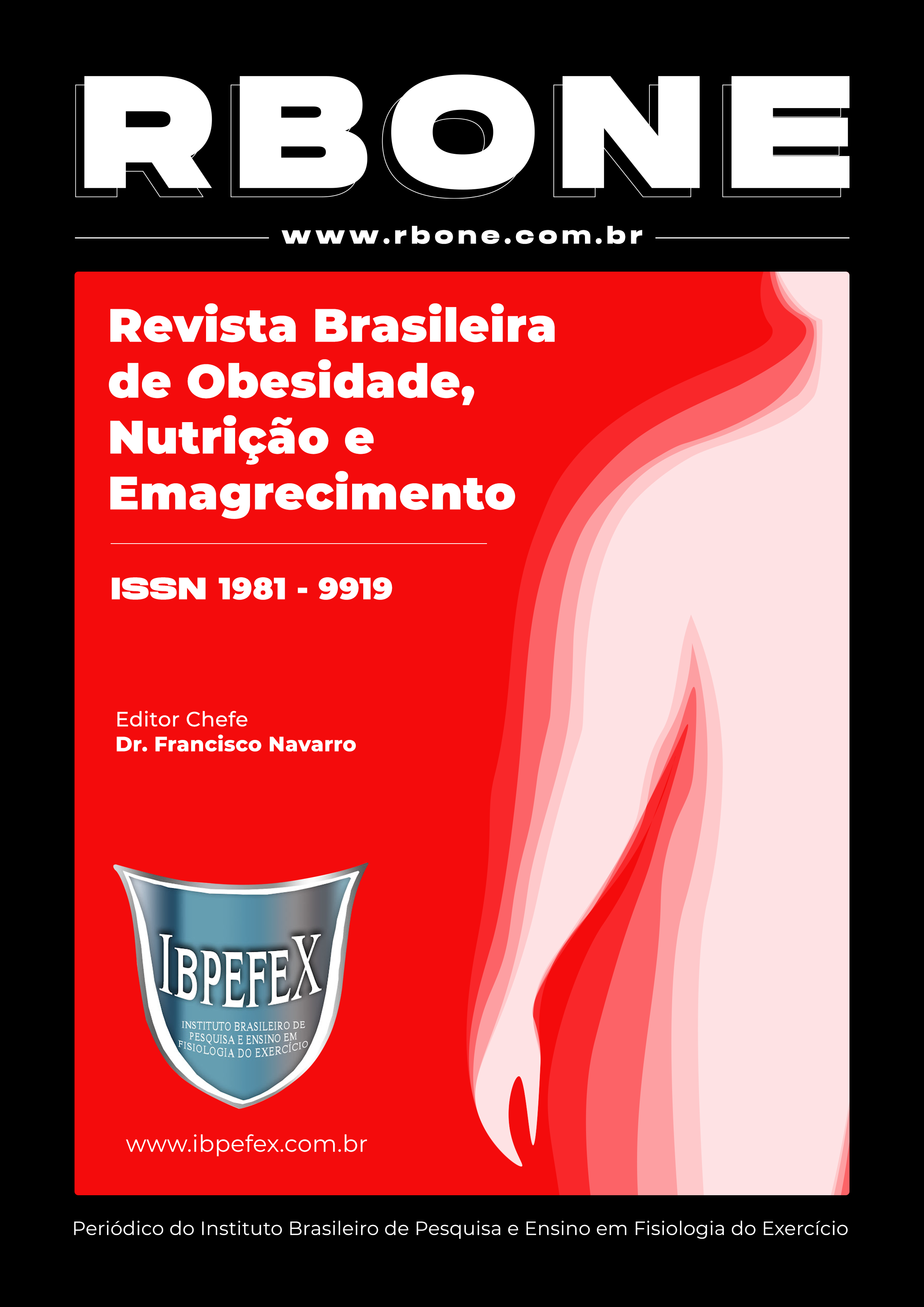Nutritional status and its association with conventional and unconventional anthropometric indicators of central adiposity in military
Abstract
Introduction: The military is characterized as a healthy and active population. The assessment of body composition and distribution of body fat becomes important to be evaluated in this audience, and risk factors may appear progressively over the years due to changes in physical activity and diet. Objective: To evaluate nutritional status and its association with conventional and unconventional anthropometric indicators of central adiposity in the military. Materials and Methods: Cross-sectional study. Study population composed of military men (≥ 18 years), the 29th Armored Infantry Battalion and the 1st Regiment of Tanks of Santa Maria-RS. Weight, height, Body Mass Index, nutritional status, age group, ethnicity and conventional anthropometric indicators (waist circumference, hip circumference, abdominal circumference and waist-hip ratio) and non-conventional (waist-height ratio and conicity index) to assess abdominal adiposity. Data were analyzed using STATA software version 12.0 and significant p<0.05. Results: A total of 142 military men participated in the study. The conventional and unconventional anthropometric variables were associated with overweight and obesity (p<0.001). Directly proportional relationship between age group and waist / hip ratio greater than 0.9; waist / height ratio greater than 5 (p=0.001) and conicity index greater than 1.25 (p=0.010) (p<0.001). Conclusion: there was a prevalence of overweight and obesity associated with abdominal adiposity assessed by conventional and unconventional anthropometric indicators.
References
-Associação Brasileira para o Estudo da Obesidade e da Síndrome Metabólica. 2009. Diretrizes Brasileiras de Obesidade. 3ª edição. 2009/2010.
-Brasil. Ministério da Saúde. Conselho Nacional de Saúde. Resolução n. 466, de 12 de dezembro de 2012. Dispõe sobre as diretrizes e normas regulamentadoras de pesquisas envolvendo seres humanos. 2012.
-Calamita, Z.; Filho, C.R.S.; Capputti, P.F. Fatores de risco para doenças cardiovasculares no policial militar. Revista Bras. Med. Trab. Vol. 7. Num. 4. 2010. p. 39-45.
-Corrêa, M.M.; Tomasi, E.; Thumé, E.; Oliveira, E.R.A.; Facchini, L.A. Razão cintura-estatura como marcador antropométrico de excesso de peso em idosos brasileiros. Cad. Saúde Pública. Vol. 33. Num. 5. 2017. p e00195315.
-Damasceno, R.K.V.; Benevides, A.C.S.; Cunha, D.O.; Lima, D.L.F.; Gonzalez, R.H.; Mendonça, F.C. Composição corporal e dados antropométricos de policiais militares do Batalhão de choque dos Estado do Ceará. Rev. Saúde e Desenvolvimento Humano. Vol. 4. Num. 2. 2016. p. 109-119.
-Hilgenberg, F.E.; Santos, A.S.A.C.; Silveira, E.A.; Cominetti, C. Fatores de risco cardiovascular e consumo alimentar em cadetes da Academia da Força Aérea Brasileira. Ciênc. Saúde Coletiva. Vol. 21. Num. 4. 2016. p. 1165-1174
-Junior, J.P.L; Cieslak, F.; Junior, M. A.V.C.; Dias, R.F. Perfil Morfofisiológico de policiais militares da cidade de Petrolina-PE. Arquivos em Movimento. Vol. 13. Num. 1. 2017. p. 43-53.
-Lee, J.H.; Seo, D.H.; Nam, M.J.; Lee, G.H.; Yang, D.H.; Lee M.J. et al. The prevalence of obesity and metabolic syndrome in the korean military compared with the general population. Journal of Korean Medical Science. Vol. 33. Num. 25. 2018. p. e172.
-Madureira, A.S.; Corseuil, H.X.; Pelegrini, A.; Petroski, E.L. Associação entre estágios de mudança de comportamento relacionados à atividade física e estado nutricional em universitários. Cad. Saúde Pública. Vol. 25. Num. 10. 2009. p. 2139-2146.
-Milagres, L.C; Martinho, K.O.; Milagres, D.C.; Franco, F.S.; Ribeiro, A.Q.; Novaes, J.F. Relação cintura/estatura e índice de conicidade estão associados a fatores de risco cardiometabólico em idosos. Ciênc. Saúde Coletiva. Vol. 24. Num. 4. 2019. p. 1451-1461.
-Nascimento, M.M.; Pereira, L.G.D.; Cordeiro, P.R.N.; Araújo, L.M.G. Comparação e concordância de critérios à classificação do IMC de idosas fisicamente ativas, residentes no Sertão Nordestino. J. Hum. Growth Dev. 2017. Vol. 27. Num. 3. 2017. p. 342-349.
-Neves, E.B. Prevalência de sobrepeso e obesidade em militares do exército brasileiro: associação com a hipertensão arterial. Ciênc. Saúde Coletiva. Vol. 13. Num. 5. 2008. p. 1661-1668.
-Oliveira, J.E.P.; Junior, R.M.M.; Vencio, S. Diretrizes da Sociedade Brasileira de Diabetes 2017-2018. São Paulo. Editora Clannad. 2017. 383 p.
-Oliveira, M.A.M.; Fagundes, R.L.M.; Moreira, E.A.M.; Trindade, E.B.S.M.; Carvalho, T. Relação de indicadores antropométricos e fatores de risco para doença cardiovascular. Arq. Bras. Cardiol. Vol. 94. Num. 4. 2010. p. 478-485.
-Teixeira, C.S.; Pereira, E.F. Aptidão Física, Idade e Estado Nutricional em Militares. Arq. Bras. Cardiol. Vol. 94. Num. 4. 2010. p. 412-417.
-Valdez, R. A simple model-based índex of abdominal adiposity. J Clin Epidemiol. Vol. 44. Num. 9. 1991. p. 955-956.
-Valdez, R.; Seidell, J.C.; Ahn Yi, K.M. A new index of abdominal adiposity as an indicator of risk for cardiovascular disease. A cross-population study. Int. J. Obes. Relat. Metab. Disord. Vol. 17. Num. 2. 1993. p. 77-82.
-World Health Organization. Obesity: preventing and managing the global epidemic. report of a WHO consultation. WHO Technical Report Series, 2000. no. 894.
-World Health Organization. Physical status: The use and interpretation of anthropometry. Report of a WHO Expert Committee. Geneva: World Health Organization; 1995. Technical Report Series, no.854.
Copyright (c) 2022 Fernanda Bordignon , Alessandra Soares Ayres Fraga , Rômulo de Oliveira Fraga , Adriane Rosa Costodio, Natielen Jacques Schuch , Karen Mello de Mattos Margutti

This work is licensed under a Creative Commons Attribution-NonCommercial 4.0 International License.
Authors who publish in this journal agree to the following terms:
- Authors retain the copyright and grant the journal the right of first publication, with work simultaneously licensed under the Creative Commons Attribution License BY-NC which allows the sharing of the work with acknowledgment of the authorship of the work and initial publication in this journal.
- Authors are authorized to enter into additional contracts separately for non-exclusive distribution of the version of the work published in this journal (eg, publishing in institutional repository or book chapter), with acknowledgment of authorship and initial publication in this journal.
- Authors are allowed and encouraged to post and distribute their work online (eg, in institutional repositories or on their personal page) at any point before or during the editorial process, as this can bring about productive change as well as increase impact and impact. citation of published work (See The Effect of Free Access).






